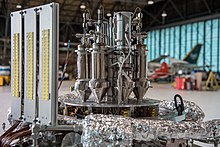Our website is made possible by displaying online advertisements to our visitors.
Please consider supporting us by disabling your ad blocker.
Kilopower
| Kilopower reactor | |
|---|---|
 Prototype NASA 1kW Kilopower nuclear reactor for use in space and planet surfaces | |
| Generation | Experimental |
| Reactor concept | Stirling engine |
| Status | In development |
| Main parameters of the reactor core | |
| Fuel (fissile material) | HEU: 235U |
| Fuel state | Solid (cast cylinder) |
| Primary control method | Boron carbide control rod |
| Neutron reflector | Beryllium oxide radial reflector |
| Primary coolant | Sodium heat pipes |
| Reactor usage | |
| Primary use | Long-duration space missions |
| Power (thermal) | 4.3–43.3 kWth |
| Power (electric) | 1–10 kW |
| Website | www |
Kilopower is an experimental U.S. project to make new nuclear reactors for space travel.[1][2] The project started in October 2015, led by NASA and the DoE’s National Nuclear Security Administration (NNSA).[3] As of 2017, the Kilopower reactors were intended to come in four sizes, able to produce from one to ten kilowatts of electrical power (1–10 kWe) continuously for twelve to fifteen years.[4][5] The fission reactor uses uranium-235 to generate heat that is carried to the Stirling converters with passive sodium heat pipes.[6] In 2018, positive test results for the Kilopower Reactor Using Stirling Technology (KRUSTY) demonstration reactor were announced.[2]
Potential applications include nuclear electric propulsion and a steady electricity supply for crewed or robotic space missions that require large amounts of power, especially where sunlight is limited or not available. NASA has also studied the Kilopower reactor as the power supply for crewed Mars missions. During those missions, the reactor would provide power for the machinery necessary to separate and cryogenically store oxygen from the Martian atmosphere for ascent vehicle propellants. Once humans arrive the reactor would power their life-support systems and other requirements. NASA studies have shown that a 40 kWe reactor would be sufficient to support a crew of between 4 and 6 astronauts.[1]
- ^ a b Cite error: The named reference
DUFF-Gibsonwas invoked but never defined (see the help page). - ^ a b Jan Wittry, Gina Anderson (May 2, 2018). "Demonstration Proves Nuclear Fission System Can Provide Space Exploration Power" (Press release). NASA. 18-031. Archived from the original on April 18, 2022. Retrieved May 2, 2018.
- ^ "Kilopower Small Fission Technology (KP)". TechPort.nasa.gov. NASA. August 9, 2011. Archived from the original on April 18, 2022. Retrieved May 16, 2018.
- ^ Hall, Loura (November 13, 2017). "Powering Up NASA's Human Reach for the Red Planet". Space Tech. NASA. Archived from the original on April 18, 2022. Retrieved November 15, 2017.
- ^ McClure, Patrick Ray (March 6, 2017). "Space Nuclear Reactor Development". Nuclear Engineering Capability Review. LA-UR-17-21904: 16. Retrieved May 16, 2018.
- ^ "Kilopower Project media slides" (PDF). NASA.GOV. NASA and Los Alamos. Archived from the original (PDF) on November 18, 2021. Retrieved January 26, 2018.
Previous Page Next Page


